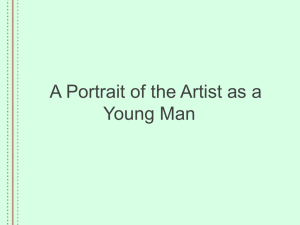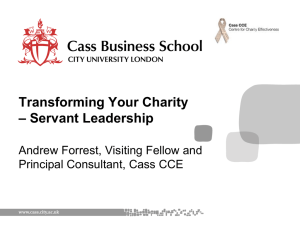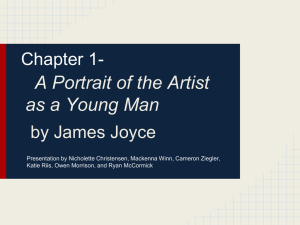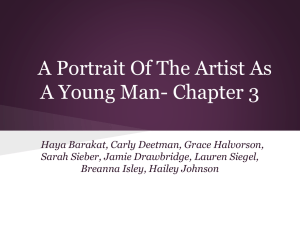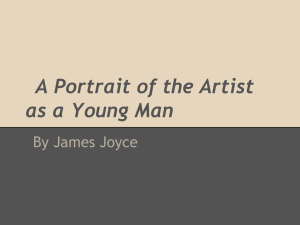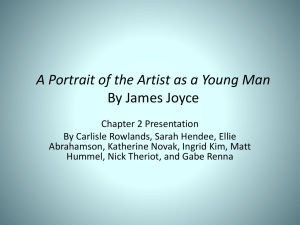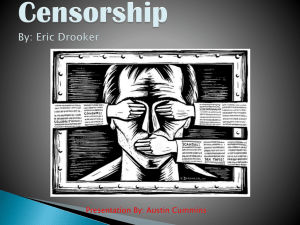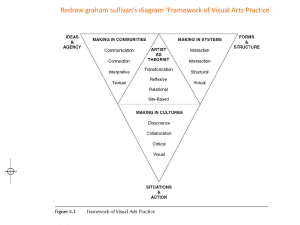A Portrait of the Artist as a Young Man by James Joyce
advertisement
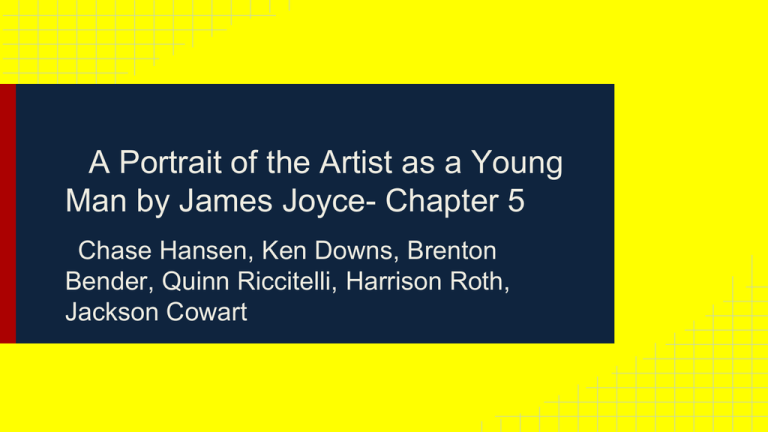
A Portrait of the Artist as a Young Man by James Joyce- Chapter 5 Chase Hansen, Ken Downs, Brenton Bender, Quinn Riccitelli, Harrison Roth, Jackson Cowart Summary Stephen is now going to a University in Ireland where he has made a handful of good friends. His peers test him and attempt to unravel the new sense of complete independence that Stephen has created for himself after realizing earlier in the story that he should not be afraid to make mistakes in life. Stephen does not submit to anyone else’s control. He only ponders silently to himself about the dynamics of aesthetics, literature, and the definition of art. He has several encounters with other people in the chapter, each measuring his moral or spiritual fortitude in some way. His parents feel that his time at the University is weakening his spiritual devotion and his friends argue that he should show more political interest. Stephen also has several small encounters with the girl he likes, Emma, and then a final confrontation at the end of the chapter during which he comes to recognize Emma as an equal rather than a beautiful exotic creature he should try to dominate and own as he did with the prostitutes in his past. Stephen realizes that his true calling is to be an artist, whether other people like it or not. It is his passion in life. His devotion to the study of prose and poetry has been constant in his life since he was a child. In the end, he decides to leave Ireland and pursue a life as an artist. Stephen’s peers descriptions of him Stephen’s peers seem to notice that he is drifting into isolation as a result of his newfound sense of freedom. His friends from the University urge him to show some kind of interest in politics like they do, but are met only by further disinterest from Stephen. His friend MacCann pushes the subject of Stephen refusing to sign a petition for “universal peace” which causes a dispute between them. MacCann believes that Stephen holds himself in such high regard as a poet and artist that he is above supporting any political movement. This would make Stephen into some kind of aloof intellectual, which is how MacCann attacks Stephen, jabbing that “Minor poets, I suppose, are above such trivial questions as the question of universal peace” (Joyce 143). By calling Stephen a minor poet, his friend calls into question everything that Stephen has learned to believe in as an “artist”. Stephen’s peers descriptions of him (cont.) Outside of the University, it is evident in the story that Stephen’s parents have grown weary of his attitude and ambitions (or seemingly a lack thereof). His mother is worried that his time at the University has changed him in a negative way, and expresses understandable disappointment while she scrubs her University aged son in the bath tub. In reaction to Stephen’s laid back attitude she says, “you'll live to rue the day you set your foot in that place. I know how it has changed you.” (Joyce 126). Mrs. Dedalus also feels that her son is reading too many books and straying from his faith. His father seems to be equally as concerned but perhaps less gentle. At one point he yells down the stairs asking Stephen’s sister, “Is your lazy bitch of a brother gone out yet?” (Joyce 126). Stephen’s parents are both under stress as their financial woes have compounded, but their lack of content with the state of their son’s life shows that they do still care about him and they Symbolic characteristics of Stephen’s peers as elements of Irish society Davin: The Passionate Patriot Stephen’s University friend Davin, nicknamed “The peasant student” (130) by his friends, believes in Irish nationalism. This reflects his background, being from a small town he grew up hearing the rhetoric of Irish Nationals. Davin’s friend’s think of him as a “Young fenian” (130) which is someone who was a member of the Fenian Brotherhood, an organization dedicated to the establishment of an independent Ireland. Davin also expresses the militant attitude of the World War One era by showing interest in joining the French Foreign Legion, a legendary French military unit comprised of entirely of fighters from foreign nations. Symbolic characteristics of Stephen’s peers as elements of Irish society (cont.) MacCann: The Pacifist Perhaps in response to the bloodshed of the first World War, MacCann is adamantly in favor of world peace. Unlike Davin, he believes that peace is more important than any violent act against authority. He attempts to convince Stephen to sign the petition for “Universal Peace” (143), targeting Stephen because he does not make an effort to voice any political opinion. In his effort to define Stephen, MacCann labels him as an “idealist” (142) and then a “reactionary” (143). Neither title is accurate. Symbolic characteristics of Stephen’s peers as elements of Irish society (cont.) The Dean: Out of touch Englishman The Dean of students at Stephen’s University reflects the conflict between English and Irish people. The Dean, an Englishman, sits down and has a conversation with Stephen in which Stephen uses an Irish word for a funnel, “tundish” (136), that the Dean has never heard before. His reaction to this curious new Irish word shows that while England was in a position of power over Ireland during that time period, they may not have been the most knowledgeable rulers. Stephen, being a speaker of Irish and English, shows a greater sense of cultural awareness than the monolingual Dean. Stephen’s Rejection of Conformity In the chapter, Stephen rejects many of the ideals that had been instilled in him from an early age. He skips classes, and eventually leaves the university. He wants to skip his Easter duty since he no longer has religious faith. He also argues with his classmates about the ideas of politics. Stephen does not, like most of his classmates, identify himself as an Irish nationalist. And finally Stephen seeks complete solitude to become a artist. Stephen pushes against all of the authority in his life. Stephen’s Increasing Freedom and Consciousness of Language Stephen begins to expand his thought. Stephen converses with his friends, generally providing the bulk of the content. Stephen shows a higher level of thinking than his peers, and he uses very complex language to express complex ideas. “Cranly’s speech, unlike that of Davin, had neither rare phrases of Elizabethan English nor quaintly turned versions of Irish idioms. Its drawl was an echo of the quays of Dublin given back to a bleak decaying seaport, its energy an echo of the sacred eloquence of Dublin back flatly by a Wicklow pulpit.” (198-199). Stephen begins to appreciate the effect of language on the meaning of what is being said. His ideas become more complex and intelligent, and he can adequately convey them. “His own consciousness of language was ebbing from his brain and trickling into the very words themselves which set to band and disband themselves in wayward rhythms”(182). Stephen’s Theory of Beauty and Aesthetics During the chapter, Stephen explains his theory of aesthetics and beauty to a fellow classmate, Lynch. Stephen begins by talking about the differences between pity and terror. Pity is the emotion that results from an outside perspective on someone else's misfortune, while terror is the emotion that results from the suffering of the sufferers. Stephen goes on to explain to Lynch kinetic and static art. Kinetic art causes an emotional response in an onlooker while the static art is created for the sole purpose of appreciating beauty. Stephen continues by explaining the three essential things needed for beauty. Integras, which is wholeness, consonantia, which is harmony, and claritas, which is radiance. Stephen then tells Lynch that appreciating these three essentials will allow one to feel “the enchantment of the heart.” Stephen feels Lynch is confused by what he has said so far so Stephen goes on to explain the differences between inferior and superior art. Inferior art only relates to the experiences of the artist which is an artistic form known as lyrical form, while superior art is able to relate to both the artist and others, a form known as epical form. Stephen finishes explaining his theory to Lynch by stating that an artist needs to step away from his work and let it speak for itself. Chapter 5 Symbols and Motifs ● ● ● ● ● ● Rain: Rain symbolizes new beginnings and the washing away of the past. The hard and faster the rain falls, the more free Stephen is from the burdens of his family, of Ireland, and of Catholicism. Art: Art represents the passion and ambition Stephen has to break away from the conformity of his peers and all of Ireland. Voices: Voices symbolize the everlasting preaching of the “blind” followers. Whether it be Stephen’s father who constantly is nagging Stephen about family, or Stephen’s peers at the University who blindly obey their zealous leaders. Poetry: Poetry symbolizes the freedom Stephen has to embrace his artistic soul. Without poetry, Stephen would be lost without an escape from Catholicism’s grasp around all aspects of his life. Birds and Flight: Birds and Flight represent Stephen’s need for escape from his family, from Ireland, and from Catholicism. Flight also represents the freedom of choice, a liberty Stephen doesn’t have without his artistic soul. Religion: In chapter 5, Stephen leaves the Catholic religion behind him as to take off the shackles which have limited Stephen’s artistic soul thus far. Religion inhibits all other aspects of Stephen’s life and symbolizes the overall control of choice. By breaking away from Catholicism, Stephen is free to have his own ideas and beliefs. Symbols and Motifs (cont.) ● ● ● ● ● Greek Mythology: The greek mythology of Icarus and Daedalus represents Stephen’s current mental stability and freedom. He escaped the “labyrinth” of Catholicism and conformity (Daedalus) with the help of his newfound artistic soul, but he needs to continue gaining knowledge so that he doesn’t end up crashing back down into “blind” conformity (Icarus). Colors: The colors represent the status of characters’ mental awareness. Lighter colors represent enlightenment while cloudy and grey colors represent a character’s confusion and submissive tendencies. The Soul: The soul represents Stephens true ambition to become an artist. Throughout the chapter, Stephen is continually lectured by his peers about Ireland and the Catholic religion, acting to limit Stephen’s true passion. Pride: Stephen’s pride symbolizes the knowledge Stephen holds over his peers. The knowledge of the many philosophers Stephen follows give him strength to stand by his non conformity attitude toward his peers and his family. Sins: Sin in chapter 5 is symbolic of religion keeping its many believers in check. Religion uses sinning to instill fear into those who would otherwise not follow the church’s teachings and authority. Mirror Images between Chapter One and Five ● ● ● ● ● ● Both Chapter One and Five end with a male Both chapters show Stephens relationship with his family and schoolmates In chapter one, Stephen is isolated by his classmates but not by choice. In chapter 5, Stephen is isolated from his peers because he chooses that lifestyle. Both chapters develop Stephen’s feelings of loneliness and separation from society In the beginning of Chapter one, Stephen is separated from a female childhood friend. In chapter five, Stephen reunites with Emma, a girl he used to have a relationship with In chapter one, Stephen’s family argues about Irish independence and Stephen stays out of it, because he is too young. In Chapter 5, Stephen refuses to support or oppose Irish nationalism because he does not want to restrict his freedom as an artist In chapter one, Stephen feels ignorant because he just started school and so knows barely anything. In chapter five, Stephen feels foolish because he uses the word “tundish” the Irish name for a “funnel.” Stephen’s Epiphany Stephen’s epiphany in this chapter occurs just after he writes his poem to Emma. He stares up at the birds in the sky, and compares them to himself. Stephen is at that moment torn between his desire to be a free artist and his loyalty and wish to conform with Ireland and his family. His mother had been urging Stephen to go to mass, in order to obey a faith that Stephen did not believe in. So the birds, to Stephen, represent the joy of freedom and “soothed his ears in which his mother’s sobs and reproaches murmured insistently” (199). Stephen is still hesitant, as he wonders whether the birds are an omen of “departure or loneliness?” However, then Stephen remembers a play he attended that had been ridiculed by the audience because they thought it was anti-Irish. This strengthens Stephens resolve to leave the society that mocks art, something that he finds repellent. The joyful freedom of the birds help Stephen to make his choice to continue to pursue freedom to express himself, and to leave Ireland, no matter what. Moment of Stasis (equilibrium) The moment of stasis in this chapter occurs just after the end of the conversation between Stephen and Cranly. Stephen had come to the realization that he was not a true man of faith and that he would not live the life of his colleagues, acknowledging that he “tried to love God” and admitting that it “seems now I failed” (242). After they converse for a while on Stephen’s rejection of religion in his life, Stephen finally is able to come to terms with his life as it should be, ruled by him and not by outside forces. He declares that he does “not fear to be alone or to be spurned for another” and that he is “not afraid to make a mistake, even a great mistake” (248). After discussing this, there is a long resolving moment of silence in which Cranly tries to gather his own thoughts. Upon being asked to clarify his prior statement, Cranly does not answer, leaving one final sustaining silence between them, one in which Stephen is able to be content and live freely in his newly adopted mindset. Change in narrative style and point of view At the very end of the novel, Joyce changes the entire narrative style and point of view by transitioning to written entries of Stephen’s, where he expresses his ideas in the first-person. This shift is crucial to the overall transformation of Stephen in the story, and it symbolizes his freedom and ability to think freely. Throughout the novel, though the reader was able to have an insight into Stephen’s mind through a limited third-person narration, Stephen never directly had a voice. Even in the last chapter when discussing the ideas of beauty and art, Stephen synthesized the ideas of great philosophers and literary figures, as opposed to providing his own. However, in the end, Stephen has finally been presented with a voice of his own, one where he has control of his thoughts and emotions, and every idea presented is his own. Even the subject matter discussed, his dreams and interactions and conversations, no longer stem from the works of others but solely from Stephen’s mind and soul. Research and Links to the Text • • • Gerhart Hauptmann: He was a German novelist and playwright who received the nobel prize in 1912. Joyce Idolized Hauptmann and thought of himself as the third in an illustrious line from Ibsen to Hauptmann to Joyce. Joyce translated two of Hauptmann’s plays to English and in A Portrait of the Artist as a Young Man Stephen mentions that he had “memories of the girls and women in the plays of Gerhart Hauptmann” (153). Guido Cavalcanti: Cavalcanti was an Italian poet in the 13th century. He was known as the second best poet of his time next to Dante. Cavalcanti was also friends with Dante who is very influential on A Portrait of the Artist as a Young Man. Stephen also says “he would recall the dark humour of Guido Cavalcanti”(155), showing his fondness for the poet. Henrik Ibsen: A very influential 19th century, playwright, director, and poet who is often referred to as “The Father of Realism. Joyce idolized Ibsen just like Hauptmann, believing he was to be the next author in the illustrious line of Ibsen and Hauptmann. Joyce’s first ever publication was a review of Ibsen’s When We Dead Awaken. In A Portrait of the Artist as a Young Man Stephen also shows the same fondness for Ibsen that Joyce showed in real life. Research and Links to the Text (cont.) • • • Ben Jonson: A 17th century Jacobean playwright who had a lasting impact on English poetry and stage comedy. Jonson is considered the second most important English playwright after William Shakespeare. In chapter five of A Portrait of the Artist as a Young Man Stephen begins to sing a song by Ben Jonson. W.B. Yeats: As 20th century Irish poet Yeats was very influential to Joyce. Yeats also served two terms as a senator and was the first Irishman to receive the Nobel Prize. In A Portrait of the Artist as a Young Man the diary entry for 16, April is an extended metaphor to Yeats’ poem “The Hosting of Sidhe”. Aristotle’s Poetics and his theories on art and other theorists: In Poetics Aristotle analyzes the things that make poetry, poetry. His core focus was on the aspect of tragedy in poetry. In A Portrait of the Artist as a Young Man Stephen often muses about Aristotle’s and other theorists such as Goethe, Lessing, and Aquinas opinions on the arts as a way to try and judge art for himself, and to find beauty in their words. Research and Links to the Text (cont.) • • The Elizabethans, The Renaissance, and French Romanticism: These were three eras in human history during which a lot of artistic development occurred. Stephen oftens thinks of artistic things from this era when he is trying to find beauty in works of literature and art. Sir Thomas Moore was an English Lawyer, philosopher, author, statesman, and humanist. He was against the Protestant reformation and burned many books relating to it. The Villanelle: The “Villanelle” is a type of poem that is highly structured and 19 lines. The poem that Stephen writes in Chapter five about his temptress is a villanelle poem. Question 1 Why do you think Emma ignored Stephen when she was exiting the library? Answer 1 Answer varies Possible answers could be… Stephen has isolated himself to the point where she didn’t think he would care if she said hello She is playing “hard to get” and secretly likes Stephen Question 2 According to Stephen, what is the difference between inferior and superior art? Answer 2 Superior art relates to the artist and its viewer, and superior art is deeper and more difficult to comprehend. Inferior art only relates to the artist, very simple and easy to understand. Question 3 Name a symbol or motif, and explain how it evolves through the book. Answer 3 Answers may vary. Question 4 Would you consider Stephen to be more like Daedalus or Icarus? Why? Answer 4 Answers may vary. Question 5 What does the changing of the narrative style signify for Stephen? Answer 5 It signifies that he finally has his own voice and can freely express his ideas. Bibliography -http://en.wikipedia.org/wiki/Fenian -http://www.britannica.com/EBchecked/topic/257058/Gerhart-Hauptmann -http://books.google.com/books?id=yRvhYjacTNoC&pg=PA2&lpg=PA2&dq=how+does+gerhart+hauptmann+relate+to+portrait+of +the+artist+as+a+young+man&source=bl&ots=Y6R230bg1M&sig=oJJje_b5xevU0fN2h6NhElkTyv0&hl=en&sa=X&ei=H15nUrPqBqvjigKW7oDwCQ&ved =0CDYQ6AEwAQ#v=onepage&q=how%20does%20gerhart%20hauptmann%20relate%20to%20portrait%20of%20the%20artist%20as%20a%20young% 20man&f=false -http://www.britannica.com/EBchecked/topic/100502/Guido-Cavalcanti -http://en.wikipedia.org/wiki/Henrik_Ibsen -http://www.jstor.org/discover/10.2307/459184?uid=3739256&uid=2&uid=4&sid=21102816537003 -http://en.wikipedia.org/wiki/Ben_Jonson http://www.jstor.org/discover/10.2307/25473616?uid=3739256&uid=2134&uid=2475497673&uid=2475497663&uid=2&uid=70&uid=3&uid=60&sid=21102 816537003 -http://en.wikipedia.org/wiki/W._B._Yeats -http://en.wikipedia.org/wiki/Poetics_(Aristotle) -http://en.wikipedia.org/wiki/Thomas_More -http://www.poets.org/viewmedia.php/prmMID/5796

